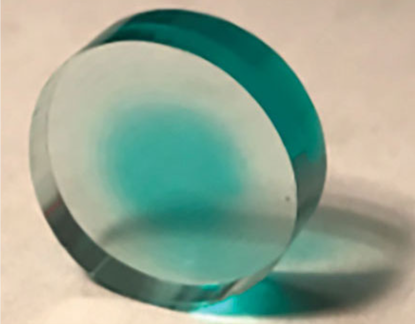Optical gain media configurations that work best for high power lasers, especially planar waveguide lasers, are not easily fabricated from single crystal boules or through standard hot-pressing techniques. There is a need in the laser industry for a cost-effective method to produce planar waveguides used for laser gain media with 3D control of the index and gain profiles in the fast, slow, and longitudinal axes. An optic of this nature could have enhanced mode stability and efficiency.
This invention is about a Material Jetting technique used to form a ceramic green body that is subsequently processed into a transparent ceramic optic with unique tunable spatial control of the composition as a function of position only achievable via additive manufacturing methods. This method uses ceramic particles loaded into a liquid slurry with required viscosity and surface tension to be jetted from a nozzle in discrete individual droplets of <1 nanoliters per droplet by using a material jetting tool. The droplets are deposited onto a substrate in thin films of desired patterns and can be layered to build up 3D structures. Since multiple nozzles loaded with different particles can be employed, it is therefore possible to fabricate structures with complex composition and optical functionality. Furthermore, since the droplets are jetted one at a time, the inherent resolution of the printed structure is dependent on the droplet size and slurry properties, allowing both rapid and gradual compositional changes.
Zachary M. Seeley, Ian R. Phillips, Thomas J. Rudzik, Nerine J. Cherepy, Alexander D. Drobshoff, and Stephen A. Payne, "Material jet printing of transparent ceramic Yb:YAG planar waveguides," Opt. Lett. 46, 2433-2436 (2021) (https://doi.org/10.1364/OL.420504)
- Enables fabrication of transparent ceramic optics with unique tunable spatial control of the composition as a function of position.
- Enables fabrication of structures with complex composition and optical functionality.
- Enables both rapid and gradual compositional changes.
- Useful for producing gain media (e.g. planar waveguide, thin disk, rod, etc.) with controlled 3D dopant and/or index profiles.
- Offers enhanced mode stability and efficiency improvements over conventional devices.
- Fabrication of transparent ceramic optics with complex composition and optical functionality.
- Fabrication of transparent ceramic optics with rapid and gradual composition change
Current stage of technology development: TRL 4-5
LLNL has filed for patent protection on this invention.
U.S. Patent Application No. 2023/0110835 Transparent Ceramics Fabricated by Material Jet Printing published 4/13/2023


